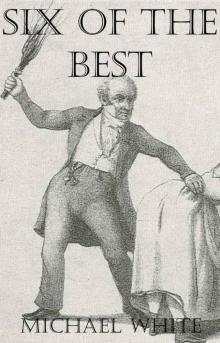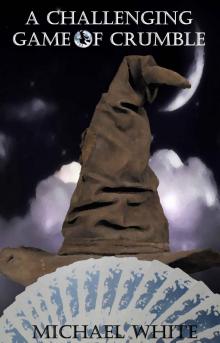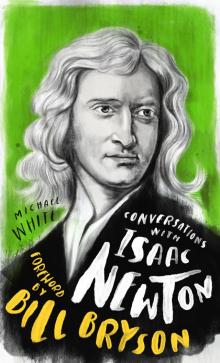- Home
- Michael White
Travels in Vermeer Page 6
Travels in Vermeer Read online
Page 6
Beneath the chin—precisely defined along the right-hand, illumined edge, but shadow-smudged on the left—she’s wearing a translucent lace scarf, nothing more than an incandescent, smoke-like swirl. Toward the left, as the scarf slips into shadow, it disappears, except for a few patches of optically-blurred white light.
The girl’s lush mouth is perhaps even more provocative than the mouth of The Girl with a Pearl Earring, but her nose complicates things. She has been called “somewhat androgynous” by Walter Liedtke (a curator at the Metropolitan Museum of Art), and that certainly applies to her rather small eyes and long Dutch nose, which is straight-bridged, with slightly large nostrils. It’s at odds with her delicate, yet arrestingly sensuous lips. Her mouth and nose are linked by a strikingly defined, sunlit cleft on the upper lip, itself part of her idiosyncratic look. Because of all these complications, it might be difficult for me to call the girl pretty, exactly, but neither does this diminish her. And I’m not off the hook. Her eyes bore into me, a moment’s dead level appraisal from arm’s length, over her right shoulder—just as the Mauritshuis girl glances from across her own left shoulder. The scale of both paintings puts me within inches of a face, a gaze, which sees through me completely.
But the shadowed gaze of this tiny girl gives nothing up—unlike the other’s eyes, which give away all. The upper two-thirds of her face dissolves, the right ear little more than a beige semi-circle. She’s wearing no makeup to bring out her eyes; and her forehead, with no visible brows or lashes, has a smooth, masklike appearance. There’s an odd—radical, even—oval green highlight floating on the surface of her right eye. In all, the neutral steadiness of her dark gaze couldn’t contrast more with the warmth of her passionate, flowery mouth—its glint of teeth, of tongue. I squint into the shadows, but I can’t tell what she’s thinking. Finally, a distinct bright pink blush fills the girl’s cheeks. She is desire and acceptance and fate, rather than comfort or understanding. This is what makes the painting so troubling, yet irresistible and paradoxically consoling to me. I can’t look away. Georgia O’Keeffe once said: “Nobody sees a flower, really—it is so small it takes time—we haven’t time—and to see takes time, like to have a friend takes time.”
After such intensity, such clawing at the heart, I puzzle over details: the strangely exotic mosaic of abstractions surrounding this particular girl. Because they are closer to us than the area in focus—which is centered on her mouth—the lion-head finials on the chair-back are a blurry jangle of reflections. The background appears as a very free, somewhat Matisse-like screen, with a calligraphic, decorative, or architectural motif. The artist’s signature is a monogram above the hat, integrated into the design.
The young girl, who she is—the dead-level particularity of her glance—gathers willfully, unforgettably, out of a ground of indeterminacy and dream, from whose depths she herself and everything around her is composed. Because I have felt such immense longing and seen it reflected in a lover’s eyes, I feel it again now in every nerve.
2. Balance
When I do pull away, I refocus on the larger work just to the right, Woman Holding a Balance.
There’s an ethereal simplicity, a radiance surrounding this woman that feels overtly religious. She looks beatific, I think; she looks like purity incarnate. Vermeer is inside his recurring room, his dream, and he approaches the presence of this woman with utter reverence. She stands before a table scattered with pearls and gold coins and chains, delicately holding a balance between right thumb and index finger. She is checking its accuracy by weighing nothing. (Much ink has been spilled on what the balance pans contain. The painting was traditionally called The Gold Weigher. But it’s clear, now that the work has been thoroughly cleaned, that each pan holds a small highlight of reflection and nothing else.)
Edward Snow concludes his beautiful book, A Study of Vermeer, with a discussion of this painting. He obsesses over the contrast between the woman’s serene balance and what is depicted in the painting hanging directly behind her. It’s an apocalyptic, Bosch-like Last Judgment with a seated Christ raising both arms above a writhing horde of naked sinners. Snow believes the baroque, moralizing Christian values as reflected in the wall painting are directly contradicted by the secular scene before it. He sees this triumph as the essence of Vermeer.
I crane in close to see the Last Judgment. It’s a let down, though, for as close as I get, I can hardly make out anything in the wall painting behind the woman. I polish my glasses on a shirttail and try again. I can more or less see where Christ is, and a few flame-like shapes of the sinners beneath him, but that’s about it. This might be partially due to the lighting in the small temporary space—there’s either not enough of it or too much reflection off the glass and/or the painting’s glaze. For whatever reason, the painting-within-the-painting is largely illegible, as such details often are in Vermeer’s work.
Yet when I step back and look at the woman again, I’m as defenseless before her as I was before The Milkmaid, in the Rijksmuseum. My body feels weightless, almost insubstantial, just as it did then. I stand so still I have to remind myself to breathe. But the lady here is very different: small-boned, long-limbed, her heavy-lidded attention settled sweetly on her task. One of the mysteries hovering over her—as well as the Amsterdam letter-reader—involves her bell-shaped appearance. A sliver of yellow-gold blouse peeks out from her dark blue morning coat trimmed with white fur (the same jacket as in two other Vermeers), and calls attention to the noticeable swell of her midriff. It’s difficult to tell if she’s pregnant or if Vermeer was simply accurately portraying a Dutch fashion of the time, as some experts claim. And maybe Vermeer didn’t intend her pregnancy—or anything else about her—to be read literally. There’s simply no way to know. I stare at her in childish wonder.
In The Milkmaid, I stared at the maid’s big, work-hardened left hand steadying the heavy pitcher from beneath, her wrist tanned where the mustard-yellow sleeve has been turned back. If that painting is earthen, the later Woman Holding a Balance is delicate, pure spirit. (This shift was true for Dutch art in general during Vermeer’s life, as tastes evolved from rustic to more refined, or bourgeois, subject matter.)
I notice the softness embodied in the sunlit fingertips holding the balance, the woman’s little finger extended horizontally as if to steady the gesture. The fingertips of the other hand light softly on the table’s edge, so softly she seems to lend support as much as seek it. The ink-blue tablecloth is pushed roughly back, revealing not only the jewelry and gold coins lying about the naked tabletop, but the table’s massive, intricately carved underpinnings as well. It’s about the connection, the give and take between the darkness of the world and the woman’s calming touch. Her figure is a bright star pulsing quietness into my heart.
3. Shadow Hand
There is a third hand in this painting that I can’t help gazing at for a good half hour. I’ll explain. The woman is wearing a linen cap or headdress, meant to protect the hairdo, like the one in The Milkmaid. The cap in Woman Holding a Balance is disturbingly crisp. The creases in the fabric about her brow look as if they would be sharp to the touch. The charcoal and umber shadow along the right side of her head is nuanced and striking. Very powerfully the shadow suddenly takes the shape of a human hand, and it’s eerily well defined. Almost as if by touching them with his fingers, Vermeer works with the textures and folds of the linen, subtly coaxing form from the natural drape of the cloth, so that the hand doesn’t seem contrived. I first became aware of this effect, this shadow hand, from a paragraph in Edward Snow’s Study of Vermeer. Snow describes the hand first as a “touch of death” that later grows benign. Standing here, I see it only as helpful, caressing the left side of the woman’s face, gathering all the painting’s tenderness there, at once a spiritual gesture and an optical trick.
I look at the shadow, look back at the balance. The woman herself is the equipoise the balance only alludes to: her right hand effortlessly holds the scales at rest,
her left hand lightly touches the table’s edge. It’s startling even now, as I write this, to recall the luminous, almost sculptural serenity of her face—braced by the shadow hand, and by her body’s fullness, so sweetly borne.
4. The Wall
I pore over the white-washed wall. I’m especially delighted to find a trompe-l’oeil nail with a tiny shadow here, above and to the left of the maid’s face. This effect seems to have been reproduced almost verbatim from The Milkmaid—as if to link the two great women, the two great masterpieces. But the plaster this time looks smooth to the touch, more elegant, befitting the lady’s status. All around her, the delicate umber shadows spread to the corners. I wear my eyes out staring at the nuances, as though the wall were an unabridged dictionary in a tiny font.
Finally, I marvel at the ruffs on the woman’s morning jacket that really are as irresistibly touchable as a painter could make them, and at the jewelry that consists mostly of carefully placed highlights on opaque dabs of paint—like the famous earring. Then I take a step backward in this room, where the teeming Dutch and Flemish still-lifes press in all around. I’m reminded that Dutch art of the Golden Age—whether portraits or still-lifes, or the genre scenes that dominated through the 1650s—tends to share one overriding concern: to “follow nature,” as Rembrandt advised. And, in fact, as I slip into the next room—the one that contains A Lady Writing—I’m immediately drawn into the orbit of a Rembrandt. It’s a portrait of his wife Saskia, from 1634. The expressiveness of details—the impossibly fine articulation of her bountiful red-gold curls, the evanescent lace at her throat—is simply beyond comparison. Similar details in Vermeer seem humble, if not willfully crude, in contrast.
What then is the source of Vermeer’s authority? Why is it that Dutch schoolchildren, on viewing the trickle of milk in The Milkmaid for the first time, exclaim: “It really pours!”
But no one can answer such questions. I leave that room, as well, and take a random stroll through corridor after corridor of the vast collection. There are many rooms filled with busy tableaus, large-scale pictorial histories that leave me cold today. It’s as if I were walking through the Gallery of the Western World, the landscapes and portraits leaning toward me on each side, the walls receding into the distance as far as the eye can see—when suddenly, the lights go out, and the hall, the great cathedral of canvases, goes dark.
And it’s a long, dark walk from Vermeer to Degas, when once again the human form itself is all. The lights come on, and the eye, the lens, is open.
5. Straight Shot
I find a place to sit on a marble bench in the magnificent central rotunda. In the middle of it all, there’s a winged statue of Mercury, towering above his fountain and temporarily surrounded by hundreds of potted Christmas poinsettias and amaryllis. I’m worn out. Certainly this bottom is something like the other one, I’m thinking. Of course, no one is ever grateful for the damages caused by a family breaking up, or the loss of control over one’s life that comes with alcoholism or addiction.
But I have experienced something more this time. When I walked into the room in the Rijksmuseum in Amsterdam and the force of the Vermeers broke over me like a wave, mercy and equipoise hit dead center in a soul in serious need of them. In some profound, mysterious way, those paintings had the measure of me and of my heartbreak.
Here’s the thing: Vermeer did not invent himself or the stillness and clarity of his gaze for critics and historians to mull over. More than for those who want it, the light of Vermeer is intended for those who need it. This specific purpose or reason for each work’s existence not only underscores the urgency of each work, but also might help explain why there are only thirty-five Vermeers in the world: such manifestations of clarity and grace cannot have come often to him, to anyone.
Suddenly, I realize I won’t always have this need, this purpose, the hunger that is spurring me on through galleries at closing time. I stand—my legs feel fresh again. I hurry back to the Vermeers to stand before them for the last half hour. This time, I leave my notebook in my backpack, which I stash in a corner with my jacket.
An executive-type in a khaki safari outfit comes into the room. He pauses briefly but decisively before each picture—as if checking off some box in his head—then moves on to the next. Finally, he stops directly in front of Woman Holding a Balance. I step back. He unsheathes his camera; for a moment I can see the orange dot projected by the sensor as it tracks across the canvas, settles on the woman’s throat. When I look again, he’s gone.
And now a guard comes forward and tells me, “Sir, the museum is closing.” I put my jacket on, pull myself together. The weigher of souls, counterpart of St. Michael, is still focused on her task.
Stepping out into the diffuse, rainy air, I think of Vermeer and his eleven children. How serene his vision; how manic his life must actually have been. I remember his standing debt to the baker, Hendrick van Buyten, who received one painting while Vermeer was still living and two more from Catharina, after Vermeer’s death, in settlement for the family’s bread.
Then I consider the deep, uncanny solace of Vermeer’s room: the gaze, the visual field in which we—whoever we are—take root for the moment. Look: a Vermeer. His work isn’t necessarily comforting: Girl with a Red Hat has left me feeling burned, aspersed, my heart tricked out of its hiding place.
But I feel noticeably buoyed as I follow Pennsylvania Avenue toward the side street where my car is parked. Suddenly hungry, I wonder, Is there a good restaurant nearby? Yes. I can smell the garlic, smoke, and minted lamb from a Greek café. I follow my nose; the aroma hits me hard at the next corner. After I feast, it’s six hours south on I-95, a straight shot home.
6. Poems
For ten hours a day through the next few weeks, I work on poems—happily, happily—trying to capture the images while they’re still fresh. I use the turns and rhythms of poetry to try to think my way into the heart of each scene. In my poem on Woman Holding a Balance, I write: “All we know of her is what we see: / how—weightless, effortless / as flame—she stands to face the lightfall over the umber, / oilcloth-covered table …” The poem ends on this note:
It won’t come again—
this equipoise between
the figure & the room. Vermeer is thirty-two—
the death-carts creaking through
the black smoke of North Europe. Twenty-four thousand dead
in Amsterdam this year.
In June, the war with England will resume. So it
won’t come again, I’m thinking,
not with such full-bodied ease. But for the moment,
here she stands. Is realized.
As the year goes on, I find I’ve written an entire book of poems from the Marble notebook. I call it Vermeer in Hell.
STEPHANIE
[ March ]
1. Out of My League
I’m on my way to meet Stephanie, wearing an uncomfortable, pressed shirt, when I hit town in the thick of Friday rush hour. It’s March, unseasonably warm. There are two four-lane bypasses on the outskirts of the Triangle, an inner loop and an outer loop. After I trace a complete lap going clockwise, looking for an exit that never materializes, I circumnavigate halfway back again, into bright sun, on the other loop. Although Raleigh is only two hours from Wilmington, I come only about once a year, and so don’t know my way. It feels like I’ve been toiling nowhere, in Dantesque circles, for a small eternity.
But the house, when I finally find it—by giving up, wandering off the freeway until I find a gas station with a pay phone, and calling her to get directions—couldn’t be less imposing, more ordinary. It’s an older white duplex, with the original metal awnings over the windows, on a quiet downhill street amok with parti-colored dogwoods and magnolias. I draw the handbrake and, stressed because I’m late, head for the door. There’s a tidy flowerbed where nothing has yet bloomed (I find out later there will be tulips, which we seldom see on the coast), and the boxwoods are happy. I look down a little du
biously at the roses I’m holding, which have lain limp on the passenger seat all afternoon.
Stephanie is an attorney, six months older than I am. We’ve been messaging back and forth for weeks. It’s my last Match.com date, I’ve decided; I’m feeling burnt out after only a few months. In fact, I’d already more or less quit. But my subscription hadn’t quite run out; Stephanie had seen my ad, and despite the distance, she’d winked, she’d written, she’d been the aggressor. It’s her last Match date as well, she says. One last shot. She wants to see how this works out, but then, she’s done, she says. It’s not for her, either.
Stephanie is not the sort of date a guy, this guy anyway, turns down.
What I’d liked about her profile: a somber, sober photo of a slender blond in a black shirt, not trying too hard. Her “exercise habits”: daily. Her “favorite things”: my job, poetry, daily meditation. “Last read”: legal briefs, Dylan Thomas, As Bill Sees It, your ad.
Because of the reference to As Bill Sees It, I knew she was also in recovery, and this promise of a kindred spirit was the most attractive thing about her. When I’d googled her, I’d found a photo of her entire law firm: no one smiling, standing like soldiers in glossy, dark-blue suits. The kind of shot designed for a billboard, back of a phone book. Sic ’em, I thought. She’s in front, the team-player blonde.
I’d also found, and read, a lengthy court brief she had authored, tracing the legal history of sodomy. It’s all very thorough, and I was impressed.
“You’re late,” she says. She’s standing in the center of a seamlessly low-key, modestly out-of-style stylish living room. Everything rounded, a little deco, and earth-tone. Clean.
She’s wearing iridescent, black three-quarter tights, a lavender Lycra top, and high-end Nikes. Startlingly taut and leggy, rippling unselfconsciously. Holding a bottle of Aquafina: tipping it back for a deep swig. Looking me over as she does—her eyes steel-blue, her sun-illumined hair drawn taut with a red rubber band.

 Paul McCartney's Coat
Paul McCartney's Coat The Cat Is Back!
The Cat Is Back! Laughs, Corpses... and a Little Romance
Laughs, Corpses... and a Little Romance The Waiting Room
The Waiting Room Into the Light- Lost in Translation
Into the Light- Lost in Translation Six of the Best
Six of the Best Scrapbook
Scrapbook Bob the Balloon, Al Capone and the Two Bob Bouncer
Bob the Balloon, Al Capone and the Two Bob Bouncer The King of the Cogs
The King of the Cogs A Bad Case of Sigbins
A Bad Case of Sigbins To the Lighthouse
To the Lighthouse Overboard!
Overboard! A Challenging Game of Crumble
A Challenging Game of Crumble Conversations With Isaac Newton
Conversations With Isaac Newton The Complete Adventures of Victoria Neaves & Romney
The Complete Adventures of Victoria Neaves & Romney Liverpool Revisited
Liverpool Revisited Dad Comes to Visit
Dad Comes to Visit Lachmi Bai, Rani of Jhansi: The Jeanne D'Arc of India
Lachmi Bai, Rani of Jhansi: The Jeanne D'Arc of India Barf the Barbarian in Red Nail (The Chronicles of Barf the Barbarian Book 2)
Barf the Barbarian in Red Nail (The Chronicles of Barf the Barbarian Book 2) Equinox
Equinox Barf the Barbarian in The Tower of the Anas Platyrhynchos (The Chronicles of Barf the Barbarian Book 1)
Barf the Barbarian in The Tower of the Anas Platyrhynchos (The Chronicles of Barf the Barbarian Book 1) The Medici secret
The Medici secret Jack Pendragon - 02 - Borgia Ring
Jack Pendragon - 02 - Borgia Ring The Art of Murder jp-3
The Art of Murder jp-3 Travels in Vermeer
Travels in Vermeer